 |
|||||
|
|||||
| Preview of Stamps Catalogue: VOLUME 1 |
 |
|||||
|
|||||
| Preview of Stamps Catalogue: VOLUME 1 |
Hannover - Hanovre
Currency before 1858: 1 Thaler = 24
gutengroschen, 1 gutengroschen = 12 pfennig
Currency after 1858: 1 Thaler = 30 groschen, 1 groschen = 10
pfennig
Return To Catalogue - Hanover 1853-1866 - 1853 Value and Crown issue - 1859 King George V issue - 1860 Horn and Crown issue - Postal stationery - Hanover Fournier forgeries - Hanover private issues (Mercur)
Note: on my website many of the
pictures can not be seen! They are of course present in the catalogue;
contact me if you want to purchase it.
Hanover is one of the German States. A Kingdom in the north of Germany. Chief towns are Hanover, Osnabruck, Hildesheim and Gottingen. It issued stamps from 1850 to 1866, it used the stamps of Prussia after it was annexed by that state. Most of the remainders were burned, except a few sheets. Up to about 1864 red gum was used (most reprints don't have red gum).
1 Ggr black on greyish blue 1 Ggr black on green (1851) 1 Ggr black and green (with network)
For the specialist: The 1 Grg black on greyish blue has as watermark a square frame. The 1 Ggr black on green has as watermark a wreath of oak leaves. The watermark can be used as a first check to detect forgeries. The last stamp with network is identical to the 1850 issue, except that a network has been applied and NO watermark is used. These stamps are printed in sheets of 120 (12 rows of 10).
Value of the stamps |
|||
vc = very common c = common * = not so common ** = uncommon |
*** = very uncommon R = rare RR = very rare RRR = extremely rare |
||
| Value | Unused | Used | Remarks |
| 1 Ggr black on greyish blue | RRR | *** | Watermark 'Square frame', issued December 1850 A reprint exists with no watermark , no gum and on grey paper (made in 1864) |
| 1 Ggr black on green | *** | * | Watermark 'Oak leaves'. Issued on green paper to
avoid confusion, since the 1/15 Th 1851 stamp was issued on blue paper. |
| 1 Ggr black on green | *** | * | No watermark, with network, issued 1st January 1856 |
Examples:
The above stamp is the first forgery described in Album Weeds. There should be a dot behind "EIN". The forgery above doesn't have this dot. Furthermore the mouth of the unicorn is quite different from the genuine stamps, it seems to be wide open.The lion's tongue is not as curved as in the genuine stamps and the crown on the head of the lion is very small. The harp in the arms should have 4 strings, but only has 2 in this forgery (however, this is hardly visible in the above images).

A whole sheet with Spiro forgeries with "HANNOVER" or
"LUNEBURG"
The above forgery of the 1 g value was made by Fournier, the shield is pointing towards the "O" of "HANNOVER". The head of the unicorn is different from the genuine stamps. There are many other differences with a genuine stamp, note for example that the "R" of "GGR" is placed almost horizontally, while is it slanting in the genuine stamps. A "FAUX" overprint (=forgery in French) has been applied on this particular copy. Normally these forgeries are cancelled with a double circle town cancel with no date. I have also seen this forgery in the colour black on greyish blue. These forgeries usually have a "HANNOVER" or a "LUNEBURG" circular cancel (without date).

Another forgery with no dot behind the "EIN", the lion
has no tongue, the horn of the unicorn is too far from the upper
border, etc.
Be careful for chemically changed colours of the 1 g black on green to 1 g black on blue (the 1 g black on blue is many times more valuable than the 1 g black on green). The different watermarks of the two stamps can be used to detect these forgeries.

Reprint in brown and blue or forgery?
A 'dog-head' forgery also exists, very similar to the forgery of the 1/30 Th stamp shown below (it is listed in Album Weeds as well as in Billig's handbook).

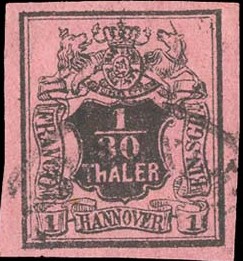
Dog-head forgeries of the 1 Ggr and the 1/30 Th value. The
unicorn looks like a dog, has a closed mouth and no beard.

Badly printed stamp with very dubious 4-ring cancel.

Reprint made in 1961.
Another forgery of the 1 Ggr exists which was made by Krauthauf according to the Bilig forgery book; I have not seen this forgery myself.
1/30 Thaler black on pink 1/15 Thaler black on blue 1/10 Thaler black on yellow
For the specialist: These stamps have an 'wreath of oak leave' watermark. The watermark can be used as a first check to detect forgeries. A private reprint of the 1/10 Th stamp exist (with no watermark). These stamps were issued on 21st July 1851 as a result of Hannover joining the German-Austrian Postal Union.
Value of the stamps |
|||
vc = very common c = common * = not so common ** = uncommon |
*** = very uncommon R = rare RR = very rare RRR = extremely rare |
||
| Value | Unused | Used | Remarks |
| 1/30 Th | R | *** | Specialists distinguish salmon or crimson colored paper. |
| 1/15 Th | R | *** | |
| 1/10 Th | RR | *** | Reprint without watermark and with white gum (1889): * |

I've been told that this is a colour trial of a 1/30 T stamp, a
1/15 T stamp and a 1/10 T stamp in the colour orange with black
center, printed together. I've also seen a 1/30 T in the colour
blue and black.
Reprints
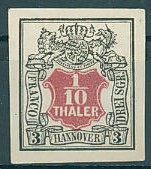
(I've been told that this is an official reprint or 'Amtliche
Neudruck' of the 1/10 Th stamp in non-issued colours: black and
red, reduced size)

A 1/30 sgr red stamp; reprint?
A minisheet with 'reprints' of all three values was made in 1966 for the 80 year existence of the 'Briefmarken-Club Hannover'. The reprints have the words 'NACHDRUCK 1966' printed at the back.
Forgeries, examples:

(Enlarged upper part, wide open mouth of unicorn, small crown on
lion's head)
The above stamp is the first forgery described in Album Weeds. The mouth of the unicorn is quite different from the genuine stamps, it seems to be wide open.The lion's tongue is not as curved as in the genuine stamps and the crown on the head of the lion is very small. The harp in the arms should have 4 strings, but only has 2 in this forgery (however, this is hardly visible in the above images).
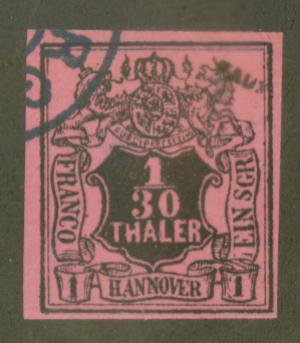

(With "FAUX" overprint from a 'Fournier Album')


(left Fournier forgery, right genuine)
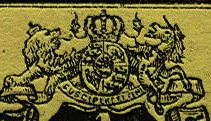

(left Fournier forgery, right genuine)
The above forgeries were sold by Fournier (see the 'Fournier album'), it has the point of the shield pointing to the center of the second "N" of "HANNOVER". All three values were forged. The head of the unicorn is different from the genuine stamp (for example the eye). The cancel on these forgeries seems always to be a city name in a double circle without any date in the center (as far as I have seen), examples "LUNEBURG" or "HANNOVER":

(Fournier forgeries, typical cancel, no date, reduced size)

Forgery, enhanced by Fournier by applying a forged cancel
"FREIBURG 17 10"
Even though Fournier sold these forgeries, I think they were made by another forger. Click here for other German States forgeries which were probably made by the same forger. And click here for other Hanover Fournier forgeries

Peter Winter made this forgery of the 1/10 Th somewhere in the
1980's.
Peter Winter made forgeries of the single 1/10 Th stamp, but also a row of 5 stamps, with one 'Kopfsteher' or tete-beche stamp in the middle. In the 'House of Stamps' catalogue such a forgery can be seen on a fake letter adressed to 'D.Edwin D.Newton at the Hospital Richmond'.


Another badly executed forgery of the 1/10 Th value. The head of
the unicorn is totally disfigured. Next to it, the same forgery
but in the wrong color. It appears as if the cancel, two
concentric circles, was printed with the design itself (since it
always appears at the same spot).

'Dog-head forgery': the unicorn looks like a dog in this forgery
of the 1/30 Th
1/30 Thaler black and pink 1/15 Thaler black and blue 1/10 Thaler black and yellow

Image reproduced with permission from: http://www.sandafayre.com
For the specialist: This stamp is identical to the 1850 issue, except that a network has been applied and they don't have any watermark. The 1/10 Th also exists with a smaller mazed network. All these stamps have red gum.

1/10 Th with small mazed network.
Value of the stamps |
|||
vc = very common c = common * = not so common ** = uncommon |
*** = very uncommon R = rare RR = very rare RRR = extremely rare |
||
| Value | Unused | Used | Remarks |
| 1/30 Th | R | *** | Issued 1st January 1856 |
| 1/15 Th | R | *** | Issued 1st January 1856 |
| 1/10 Th | RR | *** | Issued towards the end of 1855? |
Early reprints seem to have been made in 1864 (all values) and 1888 (1/10 Th only). Source: 'The Stamps of the German States' by B.W.H.Poole. They all don't have red gum but white gum.
I've been told that the above stamp is a reprint made in 1888, it has white gum instead of red gum.

A block of 5 Culemann reprints of the 1/10 Th value of 1884-91,
the network is applied stamp by stamp. The gum is not red in
color.
I presume the following text in the Vierteljahrs-Nachträge
zum permanenten Handbuch der Postfreimarkenkunde und dem
Permanent-Sammelwerk in losen Blättern von Hugo Krötzsch
(1896), page 17, refers to these reprints:
Hannover. -- Neudrucke.
Herr C. Pfäff in Hannover schreibt mir:
"In Ihrer Bearbeitung Hannover -Marken lese ich auf Seite 11
eine Abhandlung über angeblich von mir hergestellte und mit
roter Gummierung nachgeahmte Neudrucke der 1/10 Thaler-Werte.
Ich erkläre Ihnen: Diese Angaben sind nicht der Wahrheit gemäss
und will ich nicht unterlassen, Sie über das Entstehen qu.
Neudrucke zu informieren.
Aus eigener Initiative hat der Besitzer der hiesigen
Culemann'schen Druckerei, in welcher seiner Zeit die
Hannovermarken im Auftrag der Behörde hergestellt wurden,
vorgefundene 1/10 Thaler Original- Stempel benutzt, um Neudrucke
herzustellen und mich gefragt, ob ich solche verkaufen wolle. Ich
habe mich dazu verstanden und ein Quantum von etwa 10000 Stück
verkauft, wobei ich Ihnen ausdrücklich bemerke, dass alle
Marken, die aus meinen Händen kamen, nur weisse Gummierung
aufzuweisen hatten und die der I. Emission ohne
"Wasserzeichen waren.
Als der Besitzer der Druckerei erfuhr, dass es Leute gab, die
seine Neudrucke als Originale verkauften, hat er sofort
aufgehört zu verkaufen und seinen ganzen Bestand an bereits noch
hergestellten vernichtet und die Absicht ausgesprochen, die
Stempel zu vernichten.
Achtungsvoll
C. Pfaff
i. F. Gebrüder Pfaff."
Examples:
In the 1/15 Thaler the hoof of the unicorn (the animal on the right), should be very close to the shield and not, as in the above stamp, be very far away from it. The above forgery was sold by Fournier (see the 'Fournier album'), it has the point of the shield pointing to the center of the second "N" of "HANNOVER". The cancel on these forgeries seems always to be a city name in a double circle without any date in the center (see also above with the non-network issues); either "HANNOVER" or "LUNEBURG".

Strip of five 1/10 Th forgeries with "HANNOVER" cancel
(no date)


1/10 Th stamp that I do not trust: the "3"s are too
small, there are only 3 shadelines instead of 4 below the
"O" of "FRANCO". There are many other small
differences with a genuine stamp. Next to it a 1/15 Th stamp
which is probably also a forgery, the "O" of
"HANNOVER" is slanting to the left, the '2's are
slightly different. In both stamps, the tongue of the lion is
reaching too far to the right (well under the extension of the
crown).

Two forgeries, similar to the 'dog-head' forgery shown on the
issue without overprint.
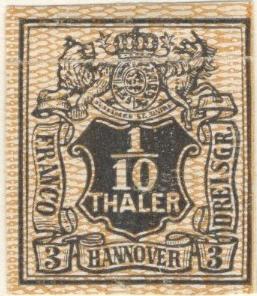
Another forgery of the 1/10 Th value.
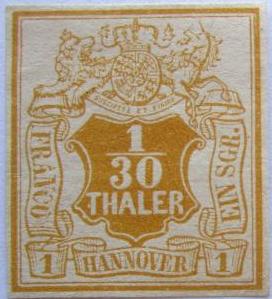



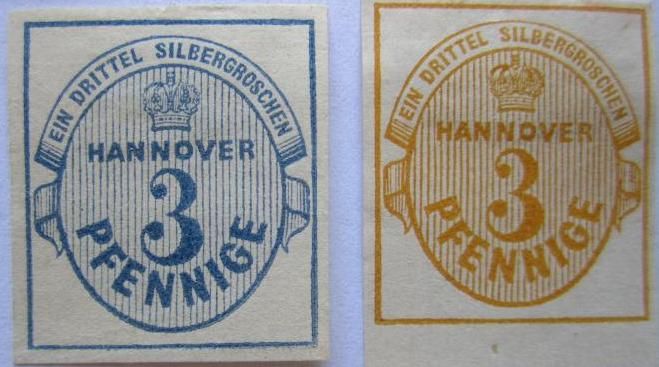
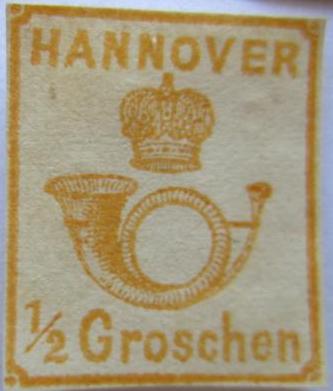
All pretending to be 'proofs', but more likely reprints.
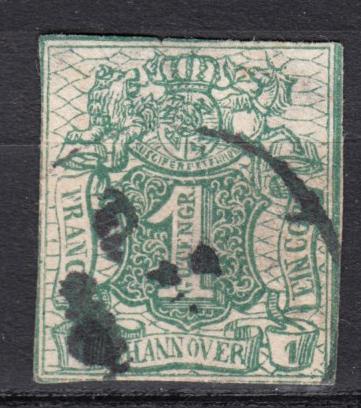
A 1 Ggr green with a very small "O" in
"HANNOVER".
For later issues of Hanover (1853-1866) click here.
Timbres et Cachets du Hanovre by S.Dreyfus edite par 'Le Monde des Philatelistes' Etude no 31 (in French).